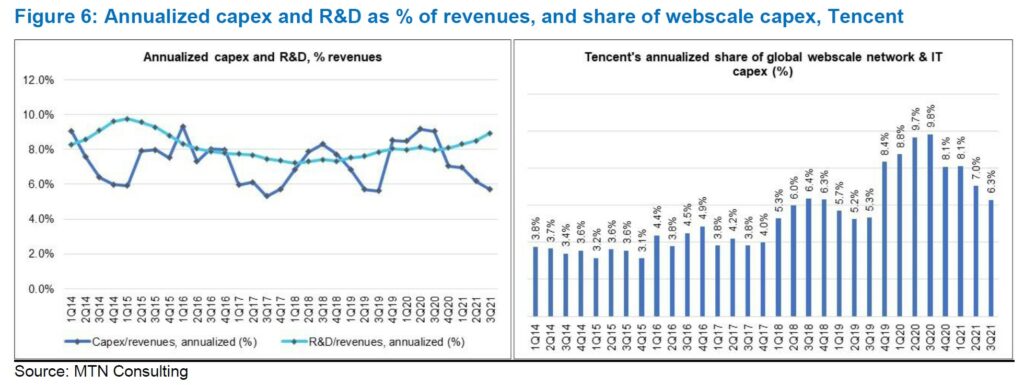By Matt Walker
Tencent is China’s largest Internet company. It has built a huge network in China to support growth of its vast digital ecosystem of services, both those provided directly and by partners. As Tencent Cloud has grown in recent years, Tencent has ramped up its spending on both network infrastructure and R&D projects aimed at deploying new services and developing more of its own network technology. The company has a proprietary approach to data center design which looks promising, it builds its own data center servers, and it has made progress in the last few months with self-design of the key ingredient of the modern data center, server chips. Last year, the company made a commitment to spend $70 billion over 5 years on cloud and related infrastructure and technology, stretching across capex and R&D spend, and it is well on its way. For the 12 months ended September 2021, capex and R&D spend totaled $4.8B and $7.5, respectively, or $12.3B in total.
Increasingly Tencent aims at the global market, in particular in the gaming and cloud arenas. Despite current government pressure on several Chinese tech players including Tencent, the company is poised to become a major global tech brand. The company has been successful in monetizing services which are provided for free (i.e. subsidized by ads) by a number of other tech providers, including Facebook (Meta) and Google (Alphabet). Tencent is one of a few top global players in the gaming market, and becoming a major media player with Tencent Pictures and Tencent Music. Tencent is investing in a number of important adjacent markets with growth potential, including connected cars and robotics. In the cloud, it is well behind China’s top player Alibaba, and further behind the global top three (AWS, Azure, and GCP), but Tencent has deep pockets, technology chops, and global ambitions. Its profile will rise considerably in the next few years. One of many reasons is its positioning to go after “metaverse” opportunities, which blend well with its technical strengths and customer base in both gaming and video.
- Table Of Contents
- Figures & Tables
- Coverage
- Visuals
Table Of Contents
- Summary
- Company overview
- Introduction
- Organization
- Revenues and profitability
- Subsidiaries, associates and investments
- International position
- Strategy and positioning
- Technology spending
- Technology suppliers
- Network infrastructure
- Overview
- Tencent Cloud
- CDN infrastructure
- Data centers
- Servers and server chips
- Data center interconnect
- Appendix
Figures & Tables
Figure 1: Tencent organizational structure
Figure 2: Revenues and profit margins, Tencent (1Q14-3Q21)
Figure 3: Tencent revenues (and other gains) by segment, 3Q21 vs. 3Q20 (US$B)
Figure 4: Tencent’s international gaming push
Figure 5: Tencent’s digital ecosystem
Table 1: Tencent’s technology spending areas in support of its corporate strategy
Figure 6: Annualized capex and R&D as % of revenues, and share of webscale capex, Tencent
Figure 7: Tencent’s expenses by nature, 2018-20 (% total opex, including D&A)
Table 2: Tencent’s key relationships with technology suppliers
Figure 8: Tencent Cloud – regions and availability zones
Figure 9: Tencent Cloud offerings
Figure 10: Tencent’s “lego” components for the T-block data center
Figure 11: OPC-4 3D Image
Coverage
Companies and organizations mentioned in this report include the following:
Ampere Computing
AOL
Apple
Arm
Baidu
Barefoot networks
Bilibili
BMW
Broadcom
ByteDance
China Aerospace Science & Industry Haiying Co. Ltd.
China Mobile
China Telecom
Chinese Communist Party (CCP)
CICC Capital
Cisco
CITIC
Comcast
Committee on Foreign Investment in the United States
Daimler
Dalian Wanda
Enflame Technology
Ericsson
Foxconn (Hon Hai)
Gao Energy
GDS Data Centers
Geely
Huada Semiconductor
Huawei
IBM
iflix
iFLYTEK
Infineon Technologies
Intel
Inventec
ixia
JD.Com
Legendary Entertainment
Lenovo
Luokung Technology
Meituan
Mellanox
Meta (Facebook)
Microsoft (Azure)
Midea
MIIT
NBCUniversal
Nintendo
Nio
Nokia
NVIDIA
Open Compute Project
Oracle
Pinduoduo
Primavera
PUBG
Qting Vision
Qualcomm
Razer
Reddit
Rosenberger
Ruijie Networks
Satellogic
Sea Ltd
Shenzhen Baoan Bay Tencent Cloud Computing Co., Ltd
Shopee
Sinoits Tech
SMIC
Snap
Sogou
STMicrolectronics
Sumo Group
Tencent Games
Tencent Music
Tencent Pictures
Tesla
TSMC
Ubisoft
Viavi
Vivo
Volvo
Warner Music
Xilinx
ZTE
Visuals


